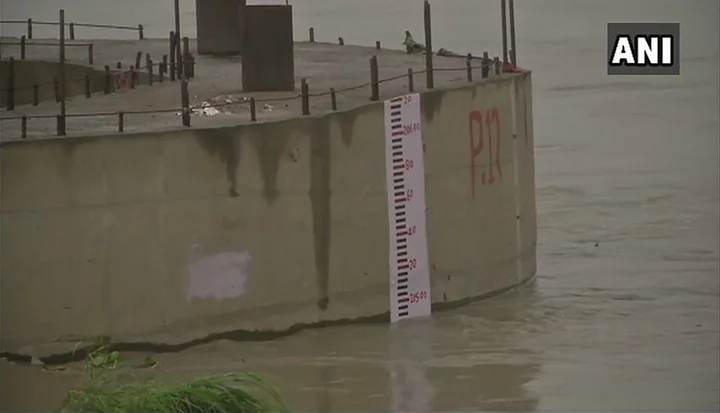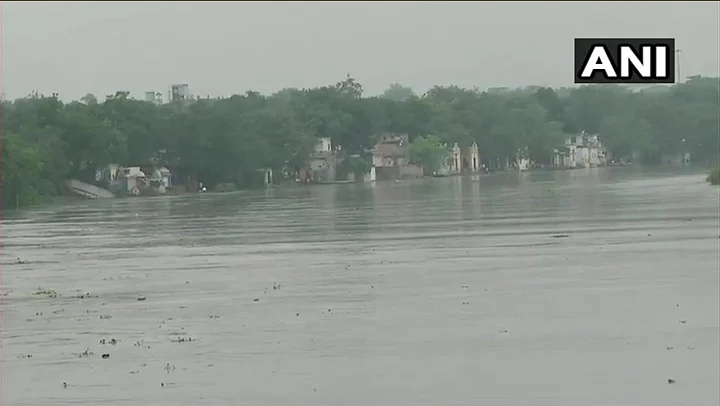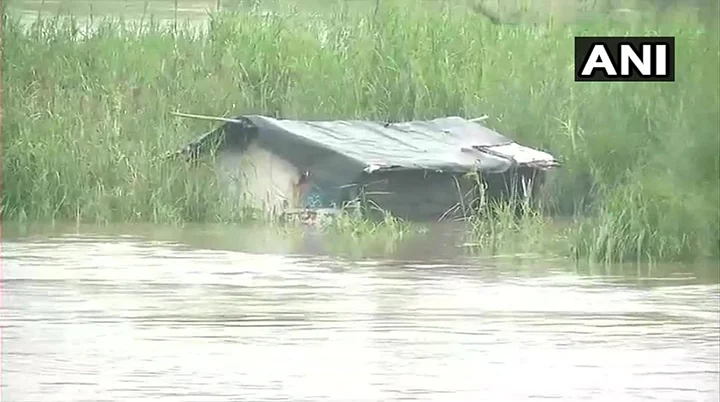Rail traffic on the Yamuna bridge has resumed, as the current water levels of the Yamuna river is still safe enough for the passing of trains, Nitin Chowdhury, the CPRO of Northern Railways, told ANI at noon on 30 July.
He said the railways engineers are stationed on the site and are monitoring the site and bridge health. The bridge was temporarily closed earlier on Monday, 30 July, after the water level in the Yamuna river rose to a dangerous level of 205.53 marks.
3,000 People Evacuated to Makeshift Camps as Yamuna Swells
The Yamuna touched the highest level in five years on 29 July, a day after it had breached the “danger mark”, government officials told Hindustan Times. By 29 July, about 3,000 people were evacuated from low-lying areas in Delhi to makeshift camps for safety.
An evacuee told ANI:
Water entered houses, now we’re on the road. There’s no arrangement for food and shelter. Rain Baseras are full. Jhuggi jhopdi waalon ko yahi milta hai. (People like us from villages get this treatment only).
Yamuna at 5-Year High
Traffic movement on the Old Yamuna Bridge in Delhi was also closed on the evening of Sunday, 29 July, with the water level in the river rising due to rains, reported PTI.
The city government set up a flood control room and a round-the-clock emergency operation centre to monitor the situation, officials said. The river was flowing at 205.5 metres on Sunday evening with the danger mark being 204.83 metres, they further told PTI.
Meanwhile, Haryana Chief Minister Manohar Lal Khattar held an emergency meeting with senior officials on Sunday, directing them to stay alert to deal with any untoward situation arising from the rising water level in the Yamuna. Khattar also conducted an aerial survey of the Hathni Kund barrage located on the Yamuna river in Yamunanagar district. The minister was reportedly told that 6,05,949 cusecs of water flowing from the Hathni Kund barrage was passing through Karnal and would reach Delhi by Monday, 30 July.
Earlier on Sunday, the District Magistrate, East Delhi, said, “1,500 people have moved from low-lying areas. 550 tents have been pitched across 10 locations in Delhi’s East district. If more people need to be evacuated and accommodated, we have schools and night shelters.”
More water is expected to reach Delhi in the subsequent days. District Magistrate East (Delhi), K Mahesh, said that the government has been prepared for this eventuality since June.
Delhi’s Chief Minister Arvind Kejriwal had also chaired an emergency meeting with all stakeholder departments of the Delhi government on Saturday after Haryana released 5 lakh cusecs of water from the Hathni Kund barrage.
All departments have been put on alert and have been directed by the CM to facilitate evacuation in the best possible manner.
Apart from swift evacuation, the teams have been directed to provide supply of power, food, drinking water and ensure medical teams are put on duty for the people being shifted for any kind of medical emergencies.
The meeting was also attended by Deputy Chief Minister Manish Sisodia. Education department and MCDs have been asked to be ready to provide the school space in these areas for people to be shifted if the situation demands. The Delhi Urban Shelter Improvement Board (DUSIB) has also been asked to chip in with their centres for people to be accommodated if required.
The Situation
Water levels in the generally sluggish river rose following torrential rainfall, which began on Wednesday, 25 July, especially in the eastern part of the Delhi-NCR region.
The Hathini Kund Barrage in northern Haryana, which feeds directly into the Yamuna, has also been releasing large amounts of water into the river periodically since 26 July, to ensure that it does not break its bounds.
The Yamuna’s highest recorded level was 207.49 metres in 1978.
It takes approximately 72 hours for the released water to make an impact on the water level in and around Delhi.
The first release on the morning of 26 July was reportedly 1.80 lakh cusecs (cubic feet per second) of water. The district administration of Yamuna Nagar, where the Barrage is located, had issued an alert to villages along the path of the river.
A further 1.15 lakh cusecs of water of water was released on 27 July by Hathini Kund Barrage as rains continued. Meanwhile, the Yamuna itself was swelling from local rainfall in Delhi.
After the Yamuna crossed the danger level of 204.83 metres on 28 July, authorities issued an advisory to take appropriate measures, in order to avoid a flood-like situation, reported PTI. Forty-three boats were deployed by the administration for relief and rescue operations, ANI reported.
Prepared to Tackle Situation: Administration
K Mahesh, the District Magistrate of East Delhi, spoke to ANI to allay fears of imminent danger to Delhi residents from the rising water levels.
We have a proactive approach. The preparation started in June. We have a 24-hour control room at East District that will continue till 15 October. Deputy commissioners and district magistrates will make arrangements for relief operations.K Mahesh, District Magistrate (East) to ANI
Sub-Divisional Magistrate (East) Arun Gupta also made a statement on the issue and relayed the immediate measures taken by the administration, to ensure the minimal loss of life and property.
Gupta said that tents are being set up at 10 locations along the path of Yamuna to provide relief to anyone affected in the area. He also issued safety warnings to residents.
We’re asking people to not let their children and cattle near the river and move to areas in the upper level. We’ve asked people not to enter into Yamuna river for swimming.Arun Gupta, Sub-Divisional Magistrate (East)
SDM Arun Gupta had announced that the administration started evacuating people from the banks as a precautionary measure, in case a flood-like situation occurs.
(With inputs from PTI and ANI)
(This is a developing story.)



